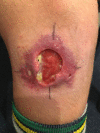The changing epidemiology worldwide of Mycobacterium ulcerans
- PMID: 30293536
- PMCID: PMC6518549
- DOI: 10.1017/S0950268818002662
The changing epidemiology worldwide of Mycobacterium ulcerans
Abstract
Mycobacterium ulcerans is recognised as the third most common mycobacterial infection worldwide. It causes necrotising infections of skin and soft tissue and is classified as a neglected tropical disease by the World Health Organization (WHO). However, despite extensive research, the environmental reservoir of the organism and mode of transmission of the infection to humans remain unknown. This limits the ability to design and implement public health interventions to effectively and consistently prevent the spread and reduce the incidence of this disease. In recent years, the epidemiology of the disease has changed. In most endemic regions of the world, the number of cases reported to the WHO are reducing, with a 64% reduction in cases reported worldwide in the last 9 years. Conversely, in a smaller number of countries including Australia and Nigeria, reported cases are increasing at a rapid rate, new endemic areas continue to appear, and in Australia cases are becoming more severe. The reasons for this changing epidemiology are unknown. We review the epidemiology of M. ulcerans disease worldwide, and document recent changes. We also outline and discuss the current state of knowledge on the ecology of M. ulcerans, possible transmission mechanisms to humans and what may be enabling the spread of M. ulcerans into new endemic areas.
Keywords: Buruli ulcer; Mycobacterium ulcerans; epidemiology; spread; transmission.
Conflict of interest statement
None.
Figures



References
-
- World Health Orgainisation (2010) Working to Overcome the Global Impact of Neglected Tropical Diseases: First WHO Report on Neglected Tropical Diseases. Geneva, Switzerland: World Health Orgainisation.
-
- World Health Organisation (2012) Treatment of Mycobacterium ulcerans Disease (Buruli Ulcer): Guidance for Health Workers. Geneva, Switzerland: World Health Orgainisation.
-
- Vincent QB et al. (2014) Clinical epidemiology of laboratory-confirmed Buruli ulcer in Benin: a cohort study. The Lancet Global Health 2, e422–e430. - PubMed
-
- Sizaire V et al. (2006) Mycobacterium ulcerans infection: control, diagnosis, and treatment. The Lancet Infectious Diseases 6, 288–296. - PubMed
LinkOut - more resources
Full Text Sources

